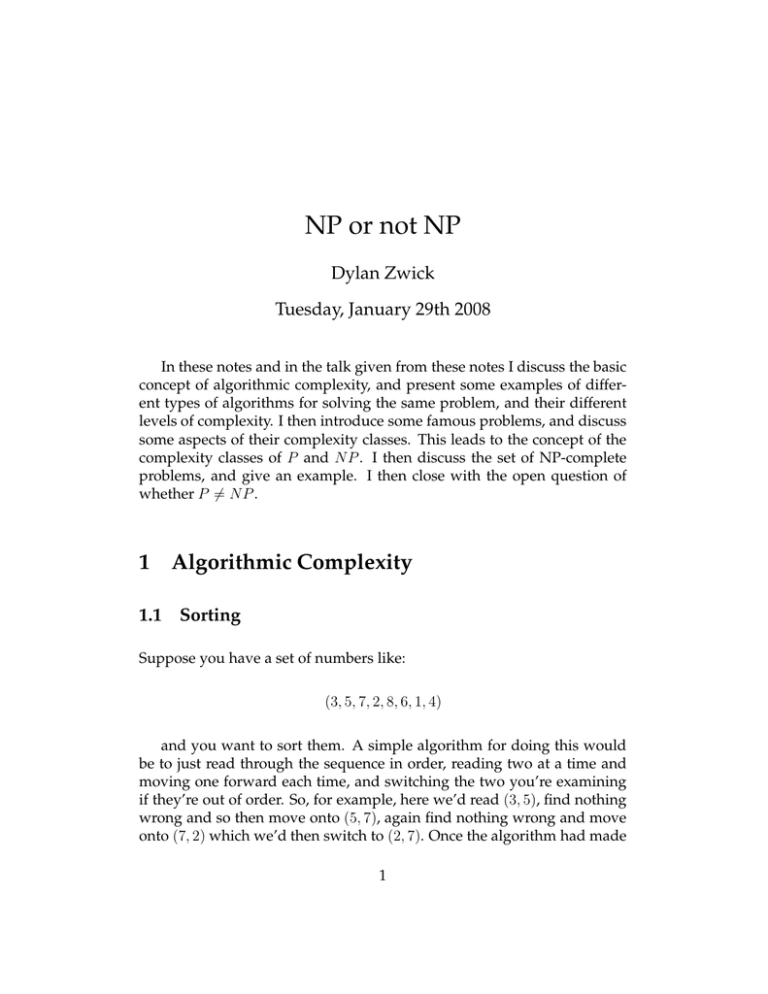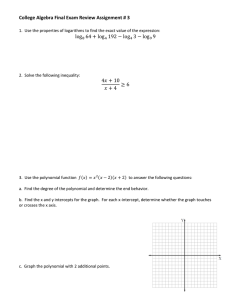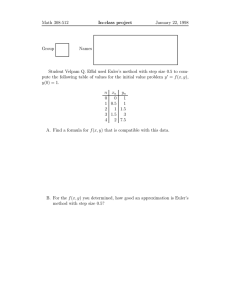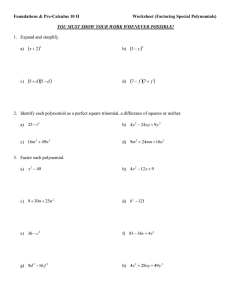NP or not NP Dylan Zwick Tuesday, January 29th 2008
advertisement

NP or not NP
Dylan Zwick
Tuesday, January 29th 2008
In these notes and in the talk given from these notes I discuss the basic
concept of algorithmic complexity, and present some examples of different types of algorithms for solving the same problem, and their different
levels of complexity. I then introduce some famous problems, and discuss
some aspects of their complexity classes. This leads to the concept of the
complexity classes of P and NP . I then discuss the set of NP-complete
problems, and give an example. I then close with the open question of
whether P 6= NP .
1 Algorithmic Complexity
1.1 Sorting
Suppose you have a set of numbers like:
(3, 5, 7, 2, 8, 6, 1, 4)
and you want to sort them. A simple algorithm for doing this would
be to just read through the sequence in order, reading two at a time and
moving one forward each time, and switching the two you’re examining
if they’re out of order. So, for example, here we’d read (3, 5), find nothing
wrong and so then move onto (5, 7), again find nothing wrong and move
onto (7, 2) which we’d then switch to (2, 7). Once the algorithm had made
1
one pass through the list it would make another pass, and continue to do
this until it had to make no switches, and therefore the list was sorted. So,
for example, after one pass our list would look like:
(3, 5, 2, 7, 6, 1, 4, 8).
This is commonly called “bubble sort”. Now, at best this method would
only have to read through a list of n numbers one time. At worst, it would
have to read through the list n times. (The best case scenario would be if
the list were already sorted, and the worst case scenario would be if the
list were already sorted, but sorted the wrong way!).
Now, another way to sort these numbers would be to first divide the
list up into two:
(3, 5, 2, 7)(6, 1, 4, 8)
and then divide these newly created smaller lists in two again:
(3, 5)(2, 7)(6, 1)(4, 8)
and continue to do this until all our sublists have two elements in them.
(We’re assuming that there are 2k elements in our list. This might seem a
bit artificial, but as algorithmic complexity is only concerned with large
scale (asymptotic) behavior we’ll find that this restriction doesn’t matter.)
Now, once all our our sublists are only of size 2, we perform bubble
sort on all of them. In other words, we exchange the numbers in a list if
they’re backwards, and do nothing if they’re correct.
Once this is done, we merge our lists in the reverse order of how we
split them. Now, here’s the important thing. If we’re merging two lists,
and we know that each list is internally sorted, then to merge them and
keep the two lists sorted we only need to perform one comparison for
each element in the two lists. For example, if we’ve got the two lists:
(2, 3, 5, 7)(1, 4, 6, 8)
2
we look at the top two elements and grab the number 1. So, 4 becomes
the top element in the right list. Then, we look at the top two elements and
grab the number 2, so 3 becomes to top element in the left list. We then
look at the top two elements and grab 3, so 5 becomes the top element in
the left list. The important thing is that, because we know our two lists are
internally sorted, we know the list we’re forming from them in this way
will be sorted itself. This type of search is typically called “merge sort”.
How long will this take? If the list is of length n then chopping the list
up will require log2 n steps, running the initial sorts will require n2 steps,
and then each merge will require n steps. However, there will be a total of
log2 n such merges. Therefore, the total running time of this algorithm will
be:
log2 n +
n
+ n log2 n + C
2
where C handles any constant time concerns (like starting up the computer).
Well, so what? The important idea is that both of these algorithms do
the same thing, but in very different ways, and one way of doing it can
take longer than another.
1.2 The Big O
When we talk about algorithmic complexity, we’re basically talking about
how long it takes to run an algorithm as a function of the size of the input
to that algorithm. In our two examples up above, the size of our input was
the number of elements in our list. Now, when talking about algorithmic
complexity, we want to know the large scale behavior of the algorithm,
which means we want to know how fast it grows as our input size gets
bigger. This means that we’re only cocerned with the fastest growing term
in our time function. In the case of the second sorting algorithm above as
n gets really big the term that will dominate will be n log n (dropping the
base, as it won’t matter). So, we say that this algorithm has a running time
that is proportional, on a large scale, to n log n. The way we would write
this would be:
3
C(mergesort) = O(n log n).
But what about our first example, with bubble sort? There we saw that
for some inputs the time required could be proportional to n2 , while for
other inputs it could be proportional to n. So, which one do we use? Well,
for big-O notation, we always use the worst case scenario input. So, for
bubble sort:
C(bubblesort) = O(n2 ).
As n log n < n2 for large n we would say that merge sort is a more
efficient algorithm. Is there a way that we could capture the idea that, at
best, bubble sort is more efficient? Yes, we use big-Omega notation. For
bubble sort we’d say:
CB (bubblesort) = Ω(n)
which says that, at best, bubble sort take a time proportional to n. Now,
note that merge sort does exactly the same thing, and takes exactly the
same time, not matter what input we give it. So, in this case the best case
scenario would be the same as the worst case scenario. In this case we
have:
CB (mergesort) = Ω(n log n).
If an algorithm has C = CB that we express that in big-Theta. So, if
both the best case and worst case running times for the algorithm are the
same, like with merge sort, we would say:
C(mergesort) = Θ(n log n).1
As mentioned earlier, we’re concerned with worst case running times,
so we always use big-O to determine which algorithm is “better”.
1
There are many other sorting algorithms, such as heap sort and quicksort. It has been
proven for any “comparison sort” algorithm that the best running time possible is n log n.
4
1.3 Two Algorithms with Massively Different Running Times
In most beginning progreamming classes you learn about the concept or
recursion. That is a funciton that calls itself, and continues to call itself
until it gets down to some base case. It then builds its final solution up
from this base case. An example:
Fibonacci_{1} (int n)
{
if(n == 0) return 0;
else if(n == 1) return 1;
else return Fibonacci(n-1) + Fibonacci(n-2);
}
This program will compute the nth term in the Fibonacci sequence for
any non-negative integer n.
Pretty slick, huh? There’s only one problem. This is a horrible way to
write this program. It’s incredibly slow. We can see why if we take a look
at how many times the program has to call the function Fibonacci for a
given input n. If n = 0 or n = 1 the answer is 1. Otherwise, the answer is:
CF (n) = CF (n − 1) + CF (n − 2) + 1
This is slightly more than F ibonacci(n). Now, the closed-form solution
for the Fibonacci terms is:
F ib(n) =
(1 +
√
5)n − (1 −
√
2n 5
√
5)n
.
This funciton increases exponentially with n, and so our Fibonacci function has a running time that is exponential as a function of it input value
n.
On the other hand, here’s an example of a program that does the same
thing, only much more efficiently:
5
Fibonacci_{2} (n)
{
int i, j, k, temp;
i = 0;
j = 1;
k = 0;
if (n == 0) return 0;
else{
while(k < n)
{
temp = j;
j = i+j;
i = temp;
k = k+1;
}
return j
}
}
This program does exactly the same thing as our earlier Fibonacci program, in that for the same input it will always returns the same output, but
it calculates the output in time that is directly proportional to the input n.
This is a huge (linear vs. exponential) improvement over our first program. The second example here is a very basic example of a programming
method called dynamic programming that can be used, if you’re clever
enough, to reduce the complexity of a program enormously.
Using our earlier notation for algorithmic complexity, here viewed as a
functin of n, we have:
√ !n
1+ 5
O(F ibonacci1 ) =
2
while
O(F ibonacci2 ) = n
6
2 P vs. NP
2.1 Euler and Hamilton Paths
Supposedly the oldest theorem in graph theory, which presaged the study
of topology, is the Konigsberg bridge problem. During Euler’s time the
city of Koningsberg was divided by the river Pregel, with two large islands
in the middle of the river. There were seven bridges connecting the city
and the two islands, and schematically the situation looked like this:
The question was, is there a way of crossing all the bridges of Konigsberg such that you only have to cross each bridge once? In 1736 Euler
proved that it’s not possible.
Euler’s result, which we’ll explain in just a moment, applies to any
graph. A path that crosses each edge of a graph once and only once is
called an Euler path for the graph in honor of Euler. An Euler path that
begins and ends on the same node is called an Euler circuit.
Euler proved that it’s possible to find an Euler path if either every node
has an even number of edges connected to it, or if two and only two nodes
have an odd number of edges connected to them. There’s even an algorithm for finding an Euler path if you know one exists. It works as follows:
1. If every node has an even number of edges, begin anywhere, if two
nodes have an odd number of edges, begin on one of these nodes.
2. Every time you land on a node record it. So, each node should have
a record of the number of times you’ve landed on it. When you’re
at a node, choose a edge from the available edge that takes you to
7
another node with the minimal number of previous visits. If there’s
a tie, any choice will do.
3. After you’ve crossed an edge, remove it from the set of available
edges.
It’s not very hard to prove, although we won’t do it here, that this algorithm will always give you an Euler path if one exists. (Run through
example)
Now, a question that might at first appear very similar is the question
of a Hamiltonian path. A Hamiltonian path is like an Euler path, only
instead of hitting every edge once and only once, a Hamiltonian path must
hit every vertex once and only once. In our earlier example a Hamiltonian
path is pretty easy to find, however if we just remove one edge to get the
following graph:
8
a Hamiltonian path no longer exists! The question of if an algorithm
exists for finding a Hamiltonian path and, if so, how complex that algorithm is leads us into the concept of NP problems.
2.2 P and NP
Let’s take a look at the Hamiltonian path problem in a little bit more detail. First, we note that if we’re given a candidate for a Hamiltonian path
(a sequence of vertices) we can quickly check to see if that sequence is a
Hamiltonian path. Second, we note that there obviously is an algorithm
for figuring out whether or not there’s a Hamiltonian path. You just enumerate all n! possible sequences of vertices (where n is the number of
vertices) and you just check them all sequentially.
If we view the input size of a graph to just be the number of vertices
and the number of edges (there are some technicalities we’re sweeping
under the rug here, that you can look up if you’re interested, but they’re
not that important) we can see pretty quick that we can verify a solution
(a sequence of edges) in a time that is polynomial in the size of the graph.
However, checking all n! possibilities potentially requires an amount of
time that is exponential in the size of the graph. So, at least using the
enumerate and check approach, we cannot determine whether there’s a
Hamiltonian path in an amount of time that is polynomial in the size of
the input.
Now, problems that are decidable (give a yes/no answer) in an amount
of time that is polynomial in the size of the input are considered to be in
a complexity class called P, which stands for polynomial. Problems that
are verifiable (you can check if a given solution works) in an amount of
time that is polynomial in the size of the input are considered to be in a
complexity class called NP.2
2
NP stands for nondeterministic polynomial. This basically means that if you could
check all possible solutions simultaneously you could solve the problem in a polynomial
amount of time. It’s equivalent to being able to verify a solution in a polynomial amount
of time.
9
2.3 NP-Completeness
Now, a very interesting property of this set of NP problems are the problems that are called NP-complete. The idea behind these problems is this.
Suppose you have two problems K1 and K2 , and for any instance of a
problem in K1 you have an algorithm, f , that would take that instance
and convert it into an instance of a problem in K2 in a polynomial amount
of time. Furthermore, for any instance x ∈ K1 the answer for that problem
is yes if and only if the answer to the problem f (x) ∈ K2 is also yes.
Well, what would that mean? That would mean that any solution algorithm in K2 could be turned into a solution algorithm in K1 . Furthermore,
a polynomial solution algorithm in K2 would automatically give rise to a
polynomial solution algorithm in K1 . Just map the problem from K1 to
K2 , and solve it using your polynomial time algorithm in K2 .
Now, the amazing thing is that there exists a class of problems, called
NP-complete problems, that have the property that any other problem
in NP can be converted into an NP-complete problem in a polynomial
amount of time. This set of problems is, in a sense, the hardest possible set
of NP problems in that if you can find a polynomial time solution to any
of the NP-complete problems then you’ve got a polynomial time solution
to every NP problem!
Now, proving a problem is NP-complete isn’t that hard as long as
you’ve got another problem that you know is NP-complete. To prove a
problem K is NP-complete we must:
1. Prove K ∈ NP .
2. Select a known NP-complete problem K ′ .
3. Construct a polynomial time mapping from K ′ to K such that the
mapping outputs a solvable instance in K if and only if the image
instance in K ′ is solvable.
Usually, that’s not very hard. An undergraduate class in complexity
theory will have you figure out many of these.
10
2.4 Two NP-Complete Problems: SAT and 3-SAT
Now, there’s a question here that’s just begging to be answered. How do
we find the first NP-complete problem? Well, as you might imagine, that’s
not a trivial problem. In 1971 Stephen Cook proved that the problem SAT
is NP-complete. The proof is not too hard, but it’s kind of long. If you want
to read it check out the book: Introduction to Automata Theory, Language, and
Computation by Hopcroft, Motwani and Ullman.
Now, the SAT problem can be stated as follows: given a set of variables
and a logical sentence, is there a truth assignment for these variables that
makes the sentence true? From our point of view a logical sentence will be
a sentence in a form that looks like:
(x1 ∨!x2 ) ∧ (x2 ∨ x3 ∨ x4 ∨ x5 ) ∧ (x3 ∨ x4 ∨!x5 )
In other words, a bunch of variables or their negations, grouped into
parenthetical groups by OR operators, with the parenthetical groups connected by AND operators. 3
Now, a truth assignment that satisfies this sentence is easy. Just set
every variable to true. However, for general logical sentences we don’t
know of any algorithm that is asymptotically better than just checking all
possible truth combinations until we find one that works. Also, it’s pretty
obvious that whether or not a given truth assignment works can be verified in polynomial time, so this set of problems is in NP.
Now, the 3-SAT problem is exactly the same as the SAT problem, only
instead of allowing arbitrary sets of variables connected by OR operators,
we only allow sets of 3 variables connected by OR operators. So, for example:
(x1 ∨ x2 ∨!x1 ) ∧ (x1 ∨!x2 ∨ x2 )
Now, the important idea here is that for any instance of SAT, we can
convert it into an instance of 3-SAT. Here’s how. Take a set of variables
connected by OR operators in a sentence in SAT:
3
This is how we’re defining a logical sentence. It can be shown that the more common
understanding of a logical sentence can always be converted into this form.
11
{x1 , . . . , xn }
Here we’re putting any set of variables connected by OR operators into
a set. If we have more than one such set, we assume these sets are themselves connected by AND operators.
Convert this set into n − 1 sets utilizing n − 1 new variables z1 , . . . , zn−3 :
{x1 , x2 , z1 }, {x3 , !z1 , z2 }, . . . , {xn , !zn−2 , zn−1 }
Now, if there a truth assignment for the variables x1 , . . . , xn that satisfies the original set then at least one of them must be true. Call that variable xr . Then if we set zr−2 to TRUE and the other values of zk to FALSE
then we satisfy each of the new sets of variables. Conversely, if the new
set of variables has an assignment that makes them true, at least one of the
xk must also be true. This conversion procedure obviously works in time
that is polynomial in the size of the original set, so we have an appropriate mapping of an NP-complete problem into 3-SAT. 3-SAT is also clearly
polynomial verifiable, so it’s in NP, and therefore 3-SAT is NP complete.
2.5 The Big Question
So, right now nobody knows of any algorithm that solves an NP problem
in polynomial time. However, nobody has yet been able to prove that no
such algorithm exists. In fact, proving no such algorithm exists has proven
to be a very difficult problem. So hard, in fact, that’s in a milennium
problem. In other words, if you can find a polynomial time algorithm
for any NP problem, or prove that one doesn’t exist, you’ll get $1,000,000
and fame. Put mathematically, we want to know if the set containment:
P ⊆ NP
is proper.
If you found this talk interesting and would like to know more, you
can take a computer science class on algorithms. At the U there is one
taught every fall by Suresh Venkatasubramanian. You can check out the
class webpage through his homepage.
12





